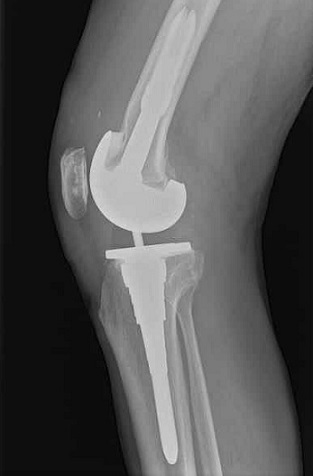Revision Total Knee Replacement
(Re Do Joint Replacement Surgery)

What is Revision Total Knee Replacement Surgery?
Revision Total Knee Replacement surgery is an operation that involves replacing a previous knee replacement with a further new artificial joint.
Revision surgery isn’t something to take lightly. It’s more complicated than a primary (or initial) total knee replacement (TKR).
A revision procedure is typically more complex than the original knee replacement surgery because the surgeon must remove the original implant, which would have grown into the existing bone. In addition, once the surgeon removes the prosthesis, there is less bone remaining.
Hence the procedure requires additional preoperative planning, specialized tools and implants and greater surgical skill. The surgery takes longer to perform than a primary initial knee replacement.
Causes
The most common reason for revision knee or hip replacement surgery is loosening of the previous implant. This loosening could be due to infection or it could be due to wear and tear of the implant which has been present for many years.
The other causes for revision knee replacement surgery are due to misalignment or instability.
The more dramatic reason for revision knee replacement surgery is fracture around the original knee replacement (periprosthetic fracture).
Symptoms
- It is important to note that revision knee replacement surgery is not offered due to just pain. There has to be a valid reason for undergoing major re do surgery. However, patients with pain after a knee replacement need to be completely investigated and examined by a knee revision specialist.
- The patient will have pain in that knee joint including a very limited walking distance with or without night pain.
- It is very important to ascertain that the pain is truly coming from the knee joint and is not referred pain from the hip or back.
- The patient may complain that the knee “gives way or collapses” under them.
- The knee feels swollen and inflamed and the patient may also report that the knee has become more “deformed”
All the above factors are vital in ensuring the correct patient is chosen to have a revision knee replacement surgery for a successful outcome. If not, and surgery is offered and performed for the wrong or incorrect reasons, the success is limited. Hence every patient has to have a complete history of complaints and duration, with a thorough examination of the previously operated knee, hip and back.
Diagnosis
- Diagnosis is made from the history and complete examination.
- It is confirmed by an x-ray of the knee which includes three specialised views including standing views.
- Sometimes further specialised views are done every few months to see if there is x-ray evidence of the previous total knee replacement becoming loose.
- An MRI scan is not needed to make a diagnosis of loosening. Sometimes a test called a radioisotope bone scan is done to see if a previous total knee replacement is loose. However, this test can only be done 18 to 24 months after the initial total knee replacement. In addition the patient may occasionally need a CT scan. The patient will also need blood tests.
- People who are experiencing problems with their original total knee replacement usually undergo an aspiration procedure to remove the fluid. The fluid is sent to a lab to determine the type of infection and whether a revision surgery is needed. This is done in the operating theatre without the need of a general anaesthetic.
Treatment
The surgery involves removing the old implant as carefully as possible and then putting in a new implant which is a more complex implant. The reason for this complexity is there always will be bone loss and hence this new implant will need to compensate for that.
The risks are higher for this type of surgery and the outcomes may not be as favourable as the results from primary surgery. However with more advanced instrumentations / implants and skills, the aim is always to get the patient back to the results of a good primary surgery.
The time of actual surgery is about 120 minutes but Mr Mahaluxmivala reassures relatives not to expect the patient back in the ward in this short time span. The reason is that a lot of care and time is taken before surgery in preparing the patient for anaesthesia, along with safe and correct positioning of the patient.
However once patients relatives know this time frame, their anxiety for loved ones is lessened knowing that safe care is given to them at all times.
Our Clinic is based at the Rivers Private Hospital in Sawbridgeworth, Hertfordshire.
